Valuing Ecosystem Function higher than material things is the paradigm shift that determines whether we understand the meaning of our lives and survive or whether we remain ignorant and selfish and destroy our own habitat trying to gain more wealth or more power. If we reach this level of understanding, not only can everyone live on the Earth but the natural systems on Earth can reach their optimal ability to sustain life.— John D. Liu (2016)
There are some practitioners who work on sustainability with a regenerative development mindset. The reason why I would say it is time to move beyond sustainability is twofold. On the one hand the term itself has been coopted and some people now call their company sustainable because it has sustained growth and profits for a number o years in a row. The term sustainability begs us to explain what it is we are trying to sustain.
The term regenerative development, on the other hand, carries within it a clear aim of regenerating the health and vitality of the nested, scale-linking systems we participate in. At a basic level regeneration also communicates not to use resources that cannot be regenerated, nor to use any resources faster than they can be regenerated. Development in this context is “co-evolving mutuality” (Regenesis Group) — so biological and cultural evolutionary development, not in the sense of economic development (only).
The second reason is that I believe we need a reframe that honours the importance of getting to ‘sustainable’ while opening the possibility to deepen our practice and go beyond merely being sustainable to actually regenerating the damage humanity has wrecked on the planet since the dawn of agriculture, city states and empires.
You can think of the path towards regenerative development as a spectrum that includes and transcends sustainability. I first came across this in an article by my friend Bill Reed, entitled ‘Shifting our Mental Models’ from 2006. Bill described a journey that starts at what you might call ‘business as usual’ — basically not breaking the law and only damaging ecosystems and societies within the limits set by regulatory bodies.
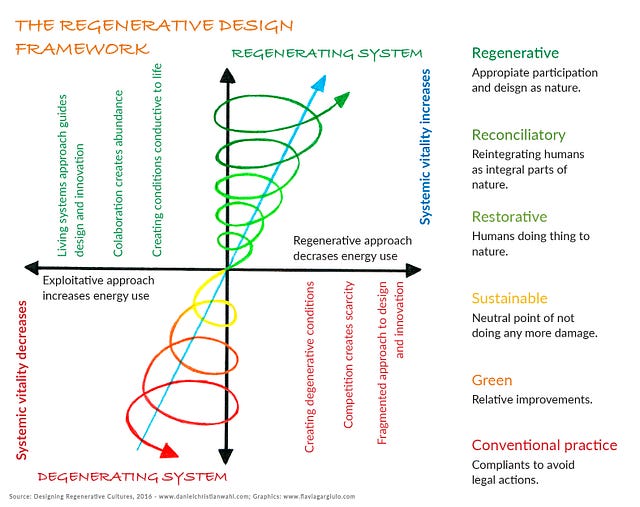
This diagram has been adapted from an early version by Bill Reed and is based on his work with Carol Sanford and colleagues at the Regenesis Group. I have changed some of the wording and added content. The green and red writing above and below the x-axis is not referring to the quadrant it is in but simply to positive impact (green) and negative impact (red). This graphic is reproduced with permission by Bill Reed in my 2016 book ‘Designing Regenerative Cultures’
From business as usual we move to ‘green’ — doing a little more than we have to legally by polluting a little less, using less energy from non renewable sources, etc. This is a step often abused for greenwashing, yet it is a necessary step on the journey. Then we get to sustainable, the neutral point of impact — not doing any additional damage. Yet we have done so much damage since the industrial revolution that we need to do more than that if we want to sustain a human population of more than 9 billion, possibly 11 billion, people by mid-Century.
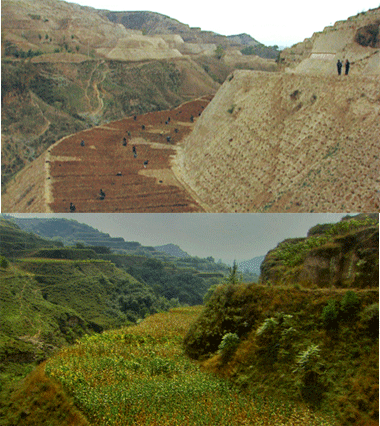 Loess Plateau in China — Source
Loess Plateau in China — Source
As we move beyond sustainability and start to work on restoring damaged ecosystems, we can still do so in a mindset that sees humanity has masters and manipulators of nature rather than as participants in its life-sustaining processes. This engineering mindset to restoration can create projects that restore forests or ecosystems at first but do so in ways that are not systemic and integrative and hence these efforts and their effects might only be short lived or result in unexpected and negative side-effects.
If large scale restoration projects fail to emerge out of or at least be deeply grounded in careful adaptation to the biocultural uniqueness of place they might deliver short-term successes but fail to create enough meaning to motivate longterm participation.
This 90 second video was produced by the media team at IED, Madrid, while I gave a workshop for their Masters in Design and Innovation in 2015.
Regenerative development reveals the latent potential of a place by connecting the system to itself and the scale-linking context it is nested in. Part of this weaving of connections is about multi-stakeholder dialogue or reconciliation of different perspectives at a higher systemic level in ways that create win-win-win solutions for all life in that place.
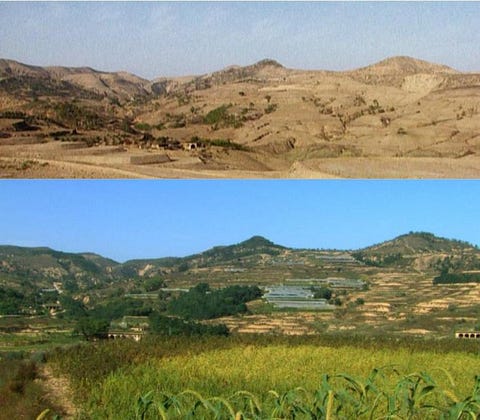 Loess Plateau in China — Source
Loess Plateau in China — Source
Only when we reconcile nature and culture and move towards understanding ourselves as part of life’s evolutionary journey and participants in life’s life-sustaining processes are we beginning to work regeneratively. As life, we are capable of creating conditions conducive to life. This is our true and proper work!
Large-scale ecosystems regeneration to reverse global warming, stabilize the climate and enable the transition to a biomaterials based economy of decentralized bioregionally focussed eco circular patterns of production and consumption is a path towards social and economic regeneration, resilience, subsidiarity and global collaboration in learning how to live well — together — on living spaceship Earth.

Permaculture Project in the Jordan Valley — Source
Regenerating the biosphere is an urgent necessity and could turn into a shared vision big enough to bring humanity together in all its diversity. We are called to be part of a maturation process of our own species and step into responsible membership of the community of life.
The 21st Century will be the century of ecosystem and Earth regeneration, otherwise the 22nd Century might see a greatly impoverished planet without us.
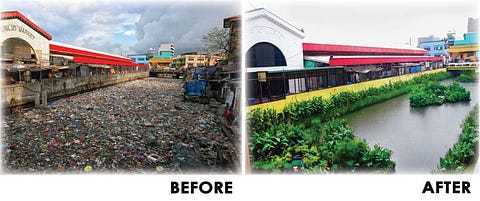
Manila, Philipines — waterway regeneration by Biomatrix Water — Source — see also this short video
Evolution proceeds by diversification and subsequent integration of that diversity at higher levels of complexity. The integration occurs predominantly through collaborative processes that increase the health of the whole system.
Humanity has brought the community of life to the brink of the 6th great extinction period of life on Earth, reversing this trend and creating a healthier and more abundant world together could offer shared meaning that helps us to reframe our diversity as a source of creativity and resilience and find common ground as one human family on a fragile planet. Working regeneratively is working with the inherent potential of living systems — — human and the rest of nature — to evolve higher levels of synergy, symbiosis and co-evolving mutuality.
“The Earth must have the potential of reaching, an “Evolutionary Climax Equilibrium”. This means that the soil, oceans, plants, animals, atmosphere, water cycle and the Earth’s climate can interact in a natural way as they did without human interference. If we are conscious of this and do not interfere with the Earth Systems, then this is possible. Knowledge is responsibility. To know that the Earth’s systems are symbiotic, living systems is to realize that it is our choice whether we will restore the Earth or whether we will continue to pretend that our interests are different that those of all living things.”— John D. Liu (2016)
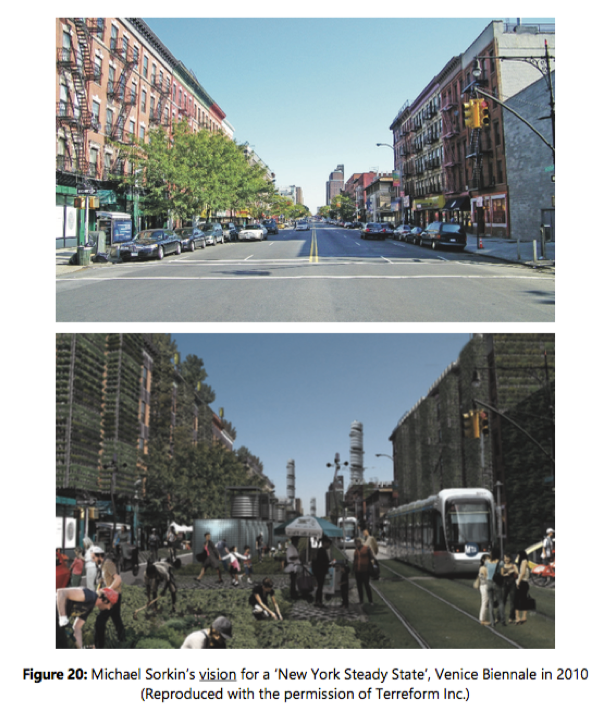
In short, regenerative development aims to optimize the whole system for all its participants rather than maximize individual parameters for a few to the detriment of many. It goes beyond not just doing no harm by regenerating healthy ecosystems functions, top-soils, forests and waterways, while also regenerating social cohesion and global solidarity and nurturing thriving communities and regional economies in global collaboration.
It is time to play your part in this work of civilizational importance. Let us come together for the healing of the Earth and her people. Let us ensure that the current epoch as we transition from the age of empire into the planetary era will be remembered as the century of regeneration!
The 4 Returns approach developed by Willem Ferwerda and the Commonland Foundation is creating a feasible pathway to begin this important work
Originally published by Medium
I have a passion for building bridges between diverse stakeholders, perspectives, disciplines, and worldviews. I bring innovation, creativity, and whole systems design to enterprises, projects, and educational programmes that foster effective collaboration in the transition towards a thriving and innovative culture of sustainability, resilience, and wellbeing. I look forward to collaborating with you.









































